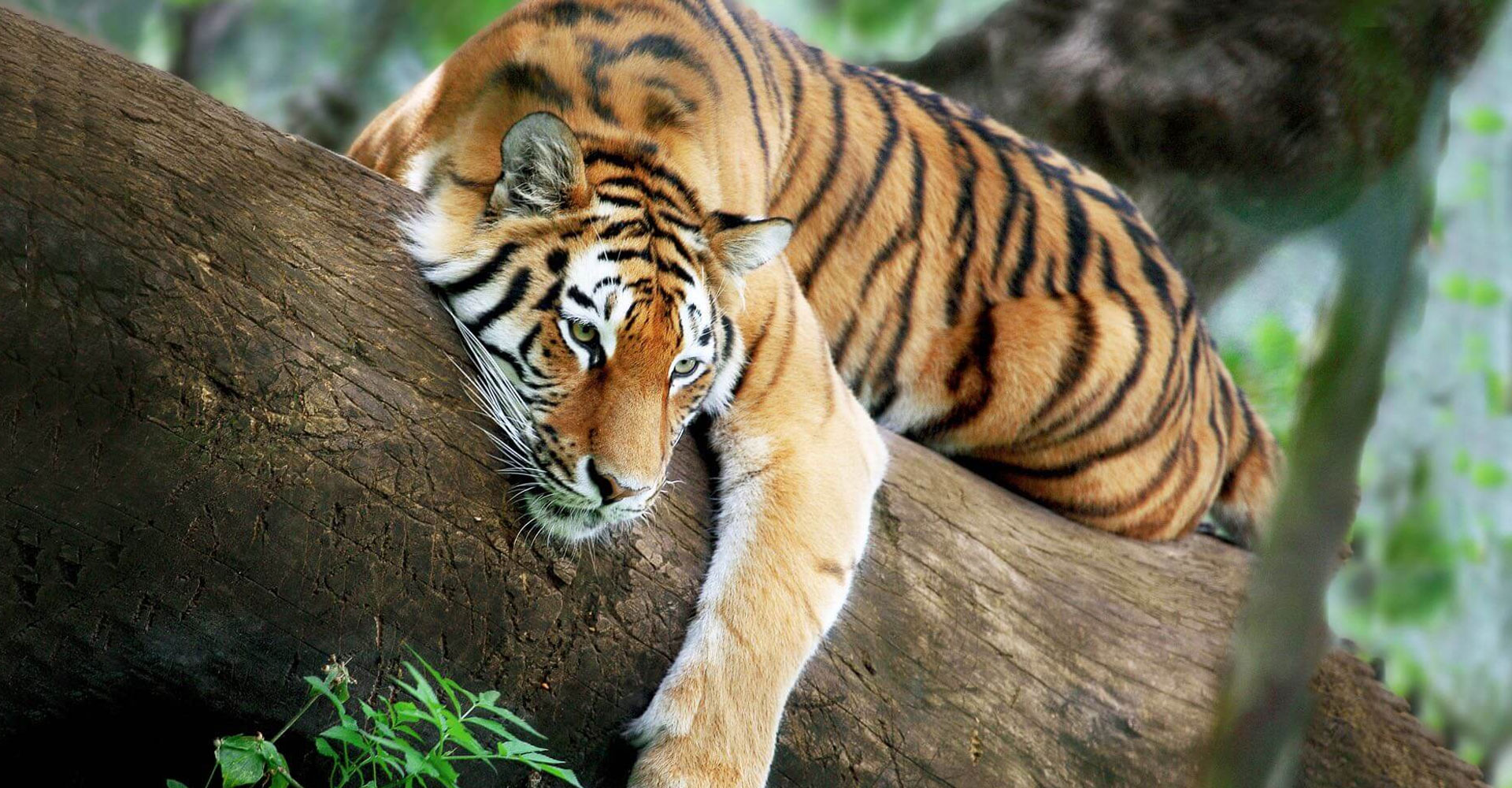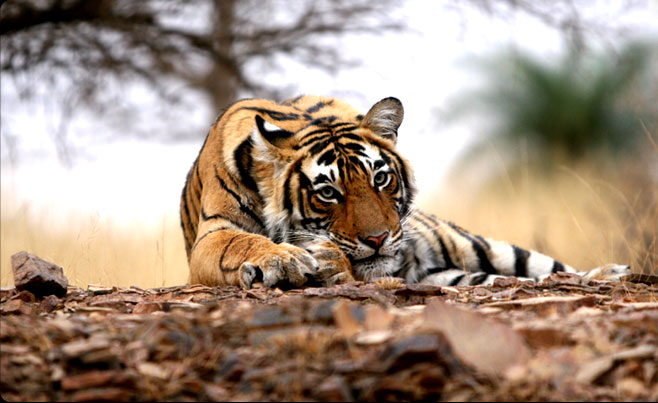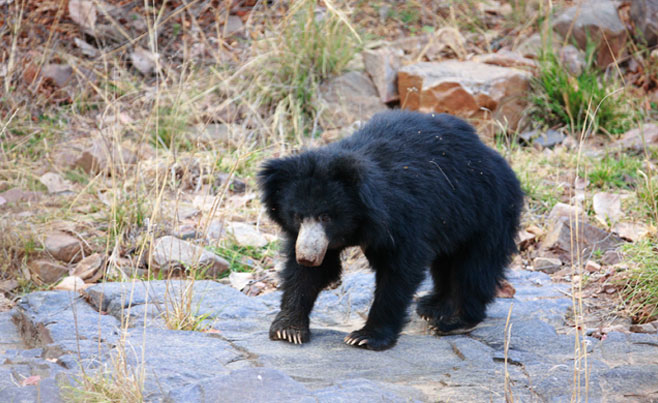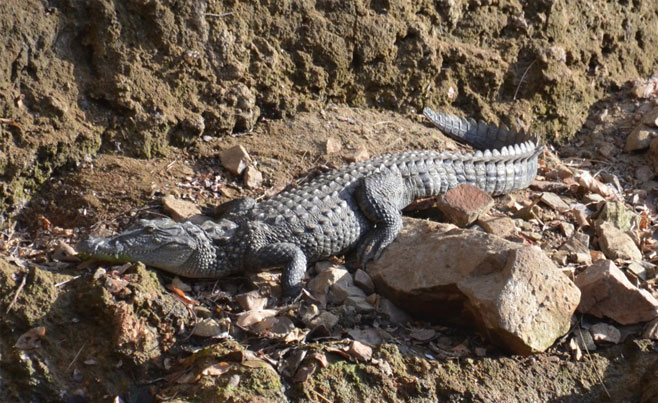Ranthambore National Park
Best Time To Visit
Jan
Feb
Mar
Apr
May
Jun
Jul
Aug
Sep
Oct
Nov
Dec
Most Popular
High Sighting
Park Closed
Low Sighting
About Ranthambore National Park
Species
Tiger, Sloth bear, leopard, Sambar, Chital, Crocodile, Caracle.
Overview
your day and you may chance upon a pack of otters or water monitors here. Standing out in stark contrast to the biological desert that Rajasthan has become, the Ranthambhore forest is like a balm, its soothing effect palpable the moment one enters the portals of the massive stone ramparts of the fabled Ranthambhore Fort. Constructed to protect kings… the battlements now defend another threatened monarch -the tiger.
History & Culture
The Ranthambhore Fort, occupied for years by Raja Hamir, has lent its name to the Tiger Reserve. A Hindu battlement, it has seen a series of Muslim rulers try unsuccessfully to lay siege to it, including Allaudin Khilji in 1301.
The army of the Moghul Emperor Akbar camped here (1558-1569) and the Akbar Namah records the menu that the generals were served when they had a meal under the famous banyan tree that visitors can still see at the base of the ramparts.
A walk up to the fort reveals legends in stone of brave warriors and tales of johar (ritual suicide) committed by more than a thousand women who mistakenly presumed their men folk had been vanquished by Khilji's forces.
Pilgrims still visit a Ganesh temple here with the same fervour as did their ancestors. The famous battis kambha chhattri (32-pillar canopy) was built by Raja Hamir to mark the 32nd year of his father's reign, and stands as an example of filial devotion.
The park area itself was once the hunting preserve of the Maharajas of Jaipur and many tiger shoots took place here including an infamous visit in the early sixties when a tiger was set up to be shot by Queen Elizabeth II.
The Ranthambhore Park earned Sanctuary status in 1958 and when Project Tiger was launched in 1973, it really began to receive the protection it deserved. Placed under the care of the now-famous Fateh Singh Rathore, by the 80s the park had earned itself the distinction of being one of the world's best-known tiger forests.
The first real signs of ecological renewal were the scores of once-dry pools, streams and rivulets that began running full of water all year long. This helped native plants to re-establish themselves. A major side-benefit of Ranthambhore's return to health was the ground water recharge service performed by the forest, which helped restock wells in surrounding villages.
Villagers in the fort still believe that when the ramparts had to be built higher, the mortar was mixed using blood from brave and fallen warriors. The fact is that many who died on the walls were buried where they fell.
As a result of quarrying for stones to build up the ramparts, water collected in the resultant depression. Over the years this became a reliable source of water for defenders and the water is still potable. However, the priest at the temple scoffs at such possibilities. He says he knows different! According to him, Sita was thirsty when she accompanied Lord Ram into the forest and he therefore shot an arrow into the ground from where water gushed out.
Terrain
After passing bare hills and sparse fields, the forest envelopes you on all sides. Five minutes into the gate, as you crest a rise on a shady road, the incredible Ranthambhore Fort looms large ahead and is every bit as impressive as the brochures promise. The park itself sprawls languidly across 824 sq. km. of contiguous, dry-deciduous forests where the rolling Vindhya and craggy Aravalli Hills meet. This is one of the last few habitats capable of supporting viable populations of Panthera tigris, the Royal Bengal Tiger.
Vegetation/Flora
It is exactly because of the activities of the creatures of the park that Ranthambhore is so rich in natural wealth. Wild fruit seeds dropped by bats, sloth bear and birds and grass seeds caught on the coats of foraging mammals only to be deposited elsewhere, in different parts of the forest, have resulted in a profusion of plant life. Wild animals are the finest gardeners of such Edens. At the eastern limits of the Aravalli the rolling hills are covered with forest flora typical of dry deciduous habitat, with dhok trees dominating the landscape. Ber, sal, pipal and banyan, the odd mango groves and scattered palm trees are among the other species that support Ranthambhore's impressive insect and birdlife.
Trails and Excursions
Wildlife sighting at Manas is neither regular nor frequent, but when it does occur, it is usually at close range. Jeep trails through the forest yield a wide variety of birds and animals. Look in the undergrowth as well as the treetops. The endangered Bengal Florican stays camouflaged along the marshes along jheels bordered by dry scrub and high Once drained for agriculture, the three perennial main lakes are integral to the success of Ranthambhore. They stand out in stark contrast against the rest of arid, deforested, desertified Rajasthan, where rivers run dry as soon as the rains end.
Animals are most active just after the sun rises and when it is about to set. At this time the forest is alive with magic as sunlight and shadows play tricks on your eyes. Try to be among the first visitors to enter the park in the morning when everything is fresh and wildlife sightings are most likely. Birds are on the hunt and in winter a soft mist is rising from the lakes.
At dusk, as you are leaving the park, the slow, sleepy pace of most creatures turns more purposeful. Birds are looking for food before roosting for the night. Tigers are about. Secretive and alert, the great cats have excellent eyesight and depend on stealth to hunt and survive. There are good chances of seeing one.
After the heat of the day, chital, sambar, wild boar and langur tend to graze in the open in the cool of the night and their alarm calls can frequently be heard, signifying that the tiger is on the move.
Visitors cannot stay in the park after nightfall, but this is when civets, hyenas, porcupines and hares are most active.
Padam Talao
Time here is well spent sitting in the shade with a pair of binoculars, watching crocs, deer and birds at this lake. Jacanas gingerly tread lily pads, pintails can be seen diving 'bottoms up' for fish. Sambar deer have been taken by crocs, apparently still and lifeless, but explosively quick when a hunting opportunity presents itself. What you thought was a rock on the lake edge might very well turn out to be a large soft shelled turtle that decided to abandon its sun bath.
Raj Bagh
Positively over photographed! Yet every eye is new and every photographer, lay or professional, should be able to come away with take-your-breath-away images of placid waters framed by the ruins of ancient hunting lodges. At any time of day, this is about as close as you will ever get to heaven. A lot of tiger action takes place here as it is a preferred spot for the favourite food of tigers, namely sambar and chital deer and wild boar.
Milak Talao
En route to Lakarda and Bakaula the third lake is an ideal spot to watch migratory geese, duck and other waterfowl that can be seen in large congregations. Ground nesters like the Lapwing sometimes put on their enchanting "broken wing" displays to lure potentially threatening intruders away from well camouflaged eggs laid in little scrapes in the ground.
As you make your way out of the park, be sure to look up at the silhouette of the Ranthambhore Fort, within whose walls at least two resident leopards are known to live.
If you dawdle after leaving the Jogi Mahal exit gate at sundown (try the steaming tea and freshly prepared alu vadas and pakoras at the exit gate), you might chance upon a ratel, blacknaped hare, civet or hyaena. Even if you don't see it, you might hear the Eagle Owl or the Brown Fish Owl. Over the years scores of tourists have reported seeing tigers and leopards on this dusk drive.
By the time you finish the morning round, have breakfast, shower and rest it is generally mid-morning and time to sit around in the shade near your lodge, or (for the energetic ones) to take a walk to a nearby village. You might like to try this at Shyampura village in the late morning to birdwatch or just take in the local flavour. The people are friendly and used to visitors, but a guide is useful, particularly as a translator.
Take a walk up to the ramparts of the fort. Apart from taking in some history and culture, the aerial view of the forest and its three lakes present you with an excellent photo opportunity. With habitat protection being Project Tiger's strike strategy to save the cat, all creatures great and small have benefited by the project's success and nothing demonstrates this better than the view from the top.
Evening campfires and conversations of the day's highlights and disappointments add a distinct flavour to a trip in the forest. Since the days end early one is quite grateful to be in bed for the rugged roads take their toll on muscles and bones and one looks forward to a good night's rest before the delights of the next day.
If you are returning by rail, it may be interesting to keep an hour before your train to browse around the market close to the railway station where local Rajasthani bangles made of glass and lac, light quilts and other household and decorative wares can be bought. Used by locals, these products are really more interesting than trivia made especially for tourists.
Special mention must be made of some fine wildlife paintings by local artists in the pichwai tradition with the tiger in its natural habitat as the focus. They make great souvenirs after a tiger trip and are available at handicraft stores. Those done at the Ranthambhore School of Art, are a little more expensive but portray expert art.
How To Reach
By Air
Jaipur is the closest airport, 132 km. away by road. From Jaipur rent a car and drive to Ranthambhore.
By Rail
Sawai Madhopur is the railway station about 14 km. away by road from the forest.
By Road
Sawai Madhopur is well connected by road to Delhi, Jaipur, Tonk, Agra and Bharatpur.
Vehicles
The best way to move around is by jeep or open-topped Cantors (mini buses). Drives can be dusty and bumpy, so take care to carry protection for expensive electronic equipment.
Tips
Winters (November-February) are cold. Be prepared with headgear, warm socks, sweaters, and windcheaters for the windchill factor. Inappropriately clad, one can be miserable in an open jeep. The early morning trip is the most exhilarating and the coldest. Daytime temperatures are comfortable in the shade (maybe a light sweater) but in the sun, a tee shirt should do fine.
If you are planning your trip in summer, stay indoors in the day and drink plenty of water. Remember to always protect the head from the sun's direct rays. It is always a good idea to do as locals do - and they use their turbans against the heat and the cold!
Carry a simple first aid kit as you would anywhere. There are really no opportunities for snake or scorpion bites.
Walking inside Ranthambhore park is forbidden and all wildlife viewing is by vehicle only. Drives can be dusty and bumpy, so take care to carry protection for expensive cameras.




